Use Scientific Method to Detection and Comparison of Menstrual Blood Samples Found at the Crime Scene
Introduction
Menstrual (liquid or stain) blood is a type of biological evidence in forensic biology & serology. Menstrual blood is discharged from the uterus in a fluid state, and it contains no fibrinogen and cannot be made to clot [1,2]. This condition is a result of a fibrinogen process during which the blood clots and subsequently reliquaries before the menstrual period. Menstrual blood or impure blood is not highly oxygenated, it’s darker than normal blood or pure blood. It is a waste product that contains dead and no longer functional tissue [3-5]. Iron, hemoglobin and protein concentration are less in menstruation than normal or pure blood. We see blood mostly following these cases such as (Rape, murder, sexual assault) and this type of case is a serious offence and identification of all body fluids organizing from sexual activities and offences has been an important aspect of forensic investigations for a long time. While reliable tests for the detection of semen, and saliva have been successfully implemented into forensic laboratories, and the detection of other body fluids, such as vaginal or menstrual fluid, is more challenging. Approving, the discrimination between peripheral and menstrual blood can be highly relevant for police investigations because it provides potential evidence regarding the issue of consent. All biological stain at the crime scene is one of the most important components in forensic science. This aids police investigation in capturing criminals as it possibly provides the investigators with all information about the crime [6]. Blood is one of the most commonly found body fluids at crime scenes, and accurate differentiation between peripheral blood and menstrual fluid could provide significant evidence, e.g, regarding the issue of consent in rape sexual assault cases. In many cases when blood is found, then the forensic expert used the TMB test for analysis of blood. TMB (tetramethylbenzidine) test is the presumptive test for blood, or it is used the founded blood is human or not. When the blood color is shown positive response that means human blood then the expert does a confirmatory blood test. Basically, in this paper further, we describe the main major difference between Normal blood/pure blood and Menstrual blood/impure blood with the help of the Teichmann test. The Teichmann test is the confirmatory blood test, and we easily identify the basic points such as the presence of cells in both types of blood, percentage of cells in both types of blood, and which blood quickly react to that particular test and give better results.
Composition of Menstrual or Impure Blood
Menstrual or impure blood is not highly oxygenated, that’s why it is darker than normal or pure blood. Menstrual or impure blood contains sodium, iron, phosphate and chloride, the extent of which depends on the women. As well as the blood, the fluid contains endometrial tissue, vaginal fluid and cervical mucus. Menstrual or impure blood contains all the five isozymes of lactate dehydrogenase LDH-1, LDH-2, LDH-3, LDH-4 & LDH-5 [7].
Material & Methods
Material
Chemical reagent including Teichmann reagent (potassium Chloride 0.1%, potassium iodide 0.1%, glacial acetic acid 10ml), Hemp fluid, Turk’s solution, Sahli’s hemoglobinometer and Haemocytometer grid, HCL, distilled water and antiserum ABH are used to detect blood group [8].
Sample Collection
The collection is done by the subjects of 30 normal women who were being selected with age groups between 18-30 years, to give menstruation and normal blood samples. Liquid menstrual blood samples collected bloodstains in sample containers and menstrual blood, or impure blood samples collected in closed plastic containers. Approximately 3 ml of blood was collected in a normal blood/pure blood sample from the same person.
Method
The Menstruation blood and pure blood are taken from the same person and the initial study was done to differentiate the blood type samples. The hemoglobin level was determined using std. Sahali’s hemoglobinometer, to which anti-coagulated blood is added 0.1 N HCl and kept for 5–7 min to form acid hematin. The colour of this acid hematin was mixed with the solution Calibration is present in the tube. Distilled water is added Color matches and then notice readings of both samples. Then RBC and WBC cells are counted with the help of Neubauer’s hemocytometer slide in both tried to sample the same person determine blood group from menstrual blood samples using the simple antisera ABH [9]. Blood group detection is done by menstrual or impure blood using antiserum ABH.
Result & Discussion
The result of the current study, we found the initial study, that is to differ the blood samples like Hemoglobin, RBC & WBC count show the great variation and this variation depends on the normal blood and abnormal blood samples of any person. In this, we observed that level of Hemoglobin, RBC & WBC is too much less in menstrual or impure blood as compared to the normal or pure blood samples. Normally the actual value of hemoglobin in pure or normal blood samples consider is 10-15gm% and in menstrual or impure blood is from 2-4gm%. In this paper, we find out that hemoglobin level in menstrual or impure blood is very low as compared to the normal blood or pure blood samples (Table 1). Based on our observation, the value of RBC cells in menstrual or impure blood is very low. The number of WBC that we identified in our results is between 6-9cu/mm in the case of normal blood or pure blood samples but in menstrual or impure blood samples the number of WBC cells is very low that is observed between 3-6cu/mm (Table 1). After the check of all cells count, we have studied a method for rapid and simultaneous analysis or examination of nucleated RBC samples and the main method and device for the simultaneous and quantitative, flow cytometric analysis of nucleated red blood cells and white blood cells from the whole blood cells. The based on these results we easily find that the composition of menstrual blood or impure blood show great variation and the content of blood like haemoglobin, RBC, WBC are present in fewer amounts in menstrual blood than the normal blood [10-11]. Based on findings, we found that menstrual blood/impure blood has less composition than normal blood/pure blood samples that give a better parameter for differentiating the menstrual blood from normal blood samples (Figures 1-6).
Table 1: Different parameters show different values exit is the blood and impure Blood Samples of The Same Individuals.
Microscopic Examination
Microscopic examination is the most important part of the field of forensic biology and serology. In this paper microscopic analysis is done by making thin smears blood is used to separate the menstruation or impure blood [12]. Normal blood or pure blood sampling and microscopy are very good parameters to separate menstrual or impure blood from normal or pure blood. PH of menstrual or impure blood samples with the help of pH paper, PH of blood samples observed at different intervals of time.
Forensic Aspect of Examination
A forensic examination was performed by the Confirmatory test by Teichmann test with menstrual or impure blood. Teichmann test was in this Teichmann solution, menstruation is performed on blood and add to the blood sample and cover with a coverslip and then heat the slide at 700C for 05 to 10 seconds and then allow it to do Cool and observe under the microscope. Then Teichmann test shows a negative result with menstruation or impure blood because the level of hemoglobin in menstrual or impure blood is very low while giving a positive result with normal or pure blood samples because the level of hemoglobin in normal or pure blood is too high [13-14]. That hemoglobin is reacted with the Teichmann reagent and gives positive results, we mention in this paper (Figure 4) [15].
Conclusion
The outcome of the result, it has been concluded that menstrual blood or impure blood gives a negative result, by using a confirmatory test (Teichmann test) because due to lack of WBC and RBC does not present in the menstrual blood samples. While we come under the scene of the crime, menstrual blood or impure blood is mostly seen in the crime of murder, rape, assault cases etc, on the onset of menstruation of the female suspect or victim. This is very useful for the identification of crime scenes due to the presence of bloodstain pattern and dead cell and hemoglobin levels in menstrual blood is much less than that of a normal blood sample. So above all parameters make it an important step for crime scene analysis evaluation and help with the reconstruction or corroboration of events.
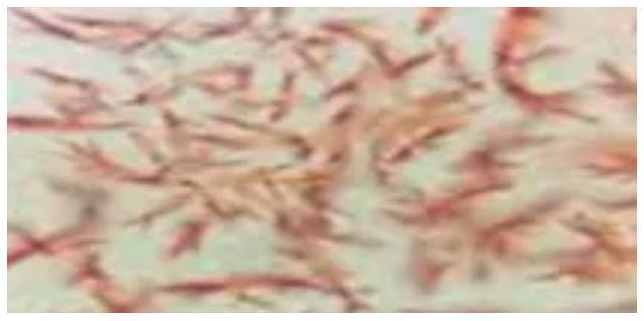

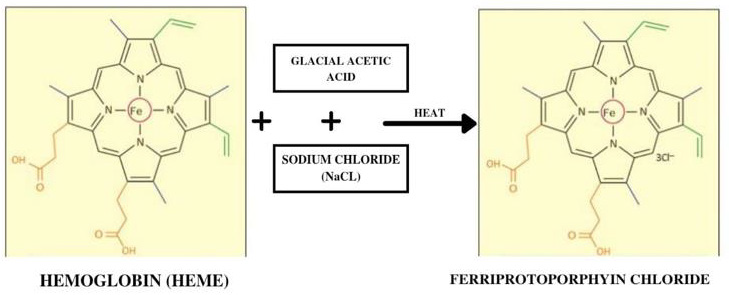
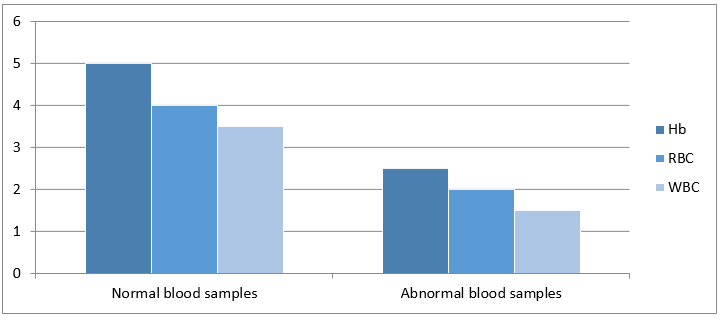
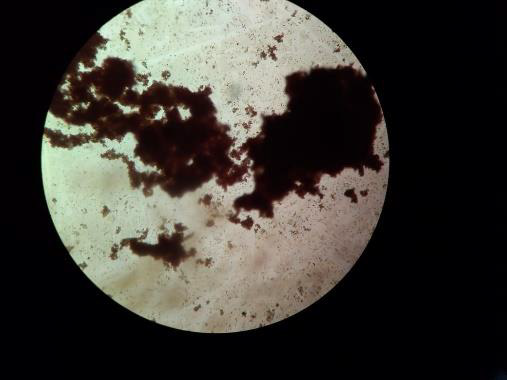
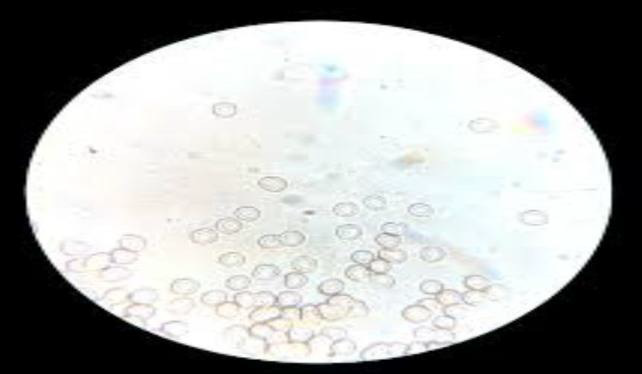
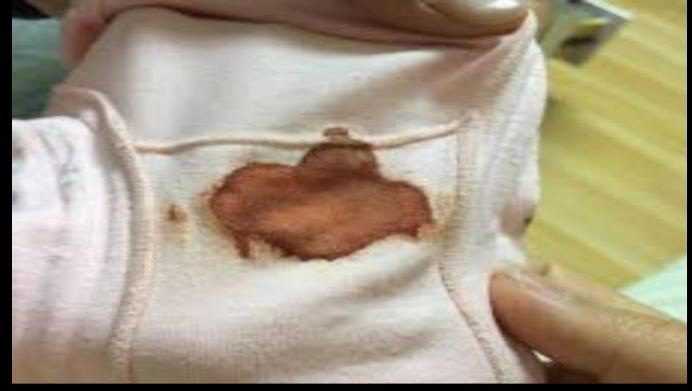


No comments:
Post a Comment
Note: Only a member of this blog may post a comment.